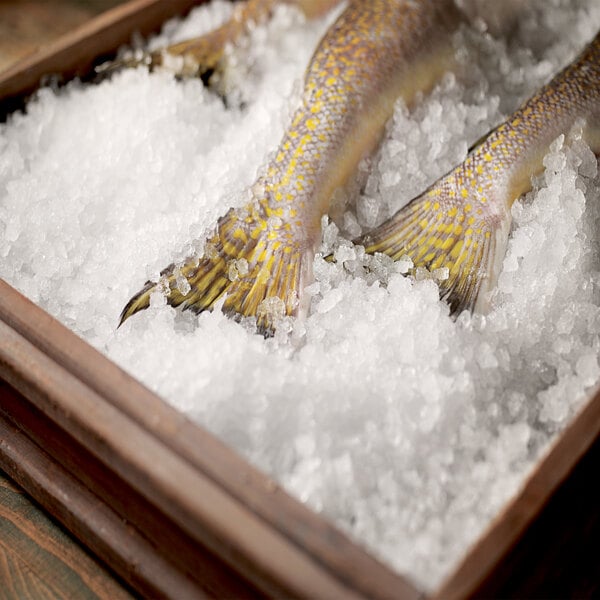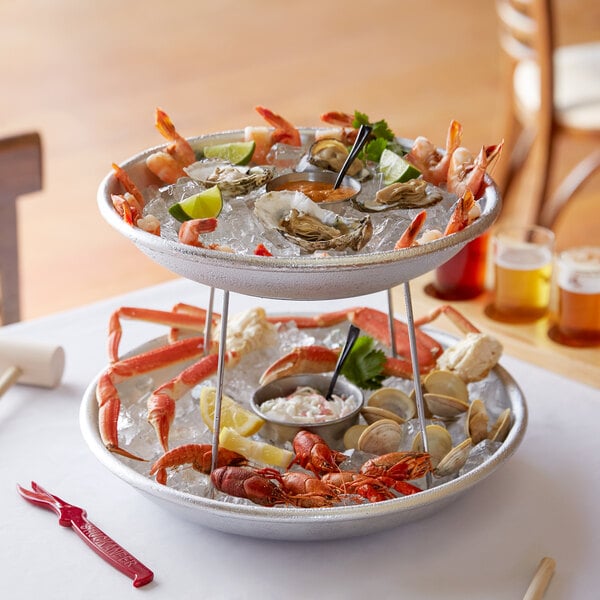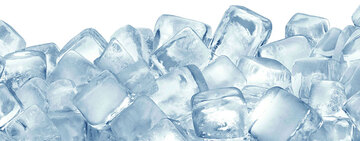
Keeping hot foods hot is usually one of the main concerns when it comes to catering and self-serve buffets. But what about cold foods? Keeping cold foods chilled is just as important for maintaining food-safe temperatures that prevent the spread of foodborne illness. Displaying foods on ice is a method to keep foods cold while also creating a visually appealing food station or serving platter. In this guide, we'll walk you through the ins and outs of safely displaying food on ice.
Benefits of Displaying Food on Ice

Placing food directly on ice when displaying or serving is beneficial for a range of reasons. Here are a few advantages to consider:
- Enhanced Presentation: Placing food on a bed of ice can elevate the visual appeal of a dish, creating an attractive display that enhances the overall presentation of the meal. When food is displayed on ice, it not only looks visually appealing but also conveys a sense of freshness and quality to guests. The contrast between the vibrant colors of the food and the glistening ice can make the dish more enticing and appetizing.
- Food Safety: By keeping certain foods chilled on ice, you can ensure that safe temperatures are maintained, which is essential in preventing bacterial growth and spoilage. This practice is particularly important for perishable items such as seafood, salads, and dairy products.
- Accessibility: One of the key advantages of using ice to display food is the improved accessibility it offers to guests. Placing food items on ice makes them easily reachable for guests, promoting self-service and encouraging interaction with the display.
How to Display Food on Ice Safely

Follow our tips for best practices when you use ice for your food displays and buffets:
1. Temperature Control
One of the most important considerations when displaying foods on ice is to maintain a consistent temperature below 41 degrees Fahrenheit, especially for TCS foods that require temperature control. Just like with a standard buffet setup, you should monitor the temperature of the foods regularly and record the information.
Do not assume the food is cold just because the ice is cold. Check food temperatures with a clean, calibrated thermometer. If you're using an infrared thermometer, make sure you're temping the food and not the ice by accident.
2. Ice Hygiene and Maintenance
Any ice that comes into direct contact with food must be clean, clear, and uncontaminated. It should be made from potable water that's safe to drink. Ice that has come into contact with raw foods can become a source of cross-contamination. Keep these foods separate from ready-to-eat foods and use barriers to prevent the ice from mingling and melting together.
When the ice in your display starts to melt, it's important to remove and refresh the ice so that it stays cold. Melted ice raises the temperature of the foods and can also affect the quality and texture. For example, a vibrant salad made with fresh greens may start to become soggy and wilted from a watery bed of ice.
3. Types of Ice
Not all ice cubes are created equally. Certain types of ice are better for use in a food display than others. Crushed or flaked ice is usually preferred because it molds to the shape of different foods. This keeps food encased in ice for the best temperature retention.
Block ice can be carved and shaped to create visually appealing displays. Ice sculptures are a unique way to set up an artistic presentation and keep foods cold at the same time. Imagine a sculpture of a human hand, palm up, holding bites of nigiri and sashimi for guests to sample. If you're organizing an upscale event, this type of display can create an unforgettable experience.
4. Consideration for Different Foods
Seafood such as freshly shucked oysters, clams, and shrimp are commonly showcased on a bed of ice to maintain freshness. To prevent spoilage, it's recommended to place the seafood on a layer of ice and regularly replenish it. It's important to avoid letting the seafood come into contact with any standing water from melted ice.
When working with raw meats and dairy products, make sure to handle them with extra caution. To maintain their quality, place them on perforated trays to allow for proper drainage and avoid direct contact with ice water.
5. Display Methods
If a bed of ice seems boring to you, there are many ways to use ice to your advantage. Get inspired by these ice display methods:
- Ice Sculptures: Ice sculptures are intricate and visually striking displays created by skilled ice carvers. These sculptures can range from simple designs to elaborate works of art.
- Carved Ice Bowls or Trays: Instead of a traditional serving bowl, how about one carved out of ice? Carved ice bowls or trays are functional and decorative pieces that can be used to chill and display seafood, fruits, or beverages. These unique ice vessels not only keep your food and drinks cold but also serve as eye-catching centerpieces.
- Ice Pillows: Shape a mound of flake ice into a pillow and present a delicate food like caviar or fish roe at the top.
- Ice Pillars or Tiers: Ice pillars or tiers are vertical ice structures that can be used to elevate and highlight food items on buffet tables or dessert displays. This create a layered effect for visual interest.
- Ice Luges: An ice luge is a sculpture made of ice that has a channel carved into it, allowing liquid to flow through and chill as it is poured. Ice luges add a fun and interactive element to any gathering, making them a unique choice for showcasing beverages.
6. Legal and Regulatory Compliance
Before getting started with any type of ice display, always double check your local health department's regulations to avoid a potential health code violation. You may be required to follow certain rules when it comes to how often you replace the ice, the types of foods you can display, and your frequency of temperature checks.
The Best Types of Foods to Display on Ice

If you're ready to get started with creating a display, there are many types of foods that benefit from being chilled on ice:
- Raw Shellfish: Raw shellfish such as oysters and clams are best displayed on ice to ensure they stay fresh and safe to consume.
- Crab Legs and Lobster Tails: These seafood delicacies retain their texture and flavor when served on ice, enhancing their visual appeal and keeping them at the perfect serving temperature.
- Chilled Shrimp: Cold shrimp arranged on ice not only look inviting but also stay perfectly chilled, maintaining their firm texture and delicious taste.
- Sushi and Sashimi: Displaying different types of sushi and sashimi on ice helps to keep the fish fresh while also creating an attractive presentation for customers.
- Ceviche: Ceviche, a popular dish made with raw fish cured in citrus juices, benefits from being served on ice to maintain its freshness and enhance its flavors.
- Salads: Keeping salads on ice helps to keep the greens crisp and fresh, ensuring they remain appetizing throughout service.
- Fresh Fruit: Displaying fresh fruit on ice not only keeps them cool and refreshing but also enhances their appearance, making them a visually appealing option for customers.
- Cheese: Certain types of cheese, such as soft cheeses and spreads, are best displayed on ice to maintain their texture and prevent them from becoming too soft.
- Cold Meats and Charcuterie: Displaying cold cuts and charcuterie on ice helps to preserve their flavors and prevent them from drying out, ensuring a delicious and appealing presentation.
Best Applications for Displaying Food on Ice

There are many different foodservice applications where you can utilize ice, a cost-efficient material, to create a pleasing display that keeps your foods chilled.
- Buffets: Displaying food on ice at buffets helps keep perishable items like salads, fruits, and seafood fresh and at a safe temperature for extended periods. Use ice beds or ice trays to present cold cuts, cheeses, and sushi for a visually appealing and hygienic buffet setup.
- Catered Events: Ice trays or ice bowls can be used to showcase shrimp cocktail, oysters, or desserts at catered events, ensuring that these items stay chilled and appetizing throughout the event.
- Restaurants: Restaurants can enhance the presentation of seafood dishes, salads, and desserts by serving them on ice beds or in ice bowls, creating a visually striking and fresh dining experience for customers.
- Food Festivals and Markets: Ice sculptures and ice displays can be used at food festivals to showcase specialty items such as artisanal cheeses, gourmet chocolates, or frozen treats, attracting and impressing festival attendees.
- Cruise Ships: Cruise ship dining experiences can be elevated by serving fresh seafood, chilled salads, and refreshing beverages on ice displays, enhancing the overall culinary experience for passengers on board.
- Trade Shows: Ice bars or ice trays can be utilized at trade shows to offer samples of chilled beverages, fruits, or hors d'oeuvres, creating an enticing and interactive display that draws in attendees.
- Grocery Stores and Delis: Displaying perishable items like fresh produce, dairy products, and deli meats on ice beds or in ice bins at grocery stores and delis helps maintain product freshness and appeal to customers seeking high-quality, well-preserved foods.
Using ice as a cooling method offers versatility in how food items can be arranged and showcased. Whether it's a seafood display, a salad bar, or a dessert station, the flexibility of ice as a cooling medium allows for creative and customizable food presentations that can cater to specific themes or events. Just make sure to practice good ice hygiene, take frequent temperature checks, and remove melted ice frequently.





